Many variables to consider here...
First: Is the bitch/stud capable of breeding?
Have they attained puberty- Most bitches will reach puberty between 6-10 months of age, however some breeds may reach puberty much later. Typically, large and giant breeds mature more slowly than toy/small breeds. Onset of puberty is not considered to be abnormal until the bitch is 24 months of age or older. Most males will attain puberty at 7-10 months of age.
Is the bitch within her breeding cycle? This may seem like an obvious statement, however to be considered: The bitch is only fertile during estrus, which occurs on average about every 7 months, and lasts about 1 week. Some bitches may stand to be mounted at times outside of their normally fertile period making timing of insemination either too early or too late. Some bitches will not stand for the male, either from lack of maturity or anxiety and will not permit breeding even during the fertile period.
Is the bitch too old to breed? Although bitches do not have menopause like women, fertility and litter size do decline with advancing age and disease like pyometra can occur with increasing incidence in older nulliparous (no previous litters) bitches.
Are there any anatomical abnormalities preventing breeding? The reproductive tract is one of the few organ systems that can sustain marked abnormalities without any significant clinical problems noted in the dog until they reach the age of puberty. As a result, there are a wide range of disorders of sexual development that can occur that may prevent successful breeding or cause pain on breeding.
Lastly, will the breeding be a natural mating, artificial insemination with fresh semen, insemination with extended cooled semen or insemination with frozen semen? Although fresh semen can remain alive in the bitch's reproductive tract up to 11 days, semen from subfertile dogs or semen that has been altered/extended to permit transport may not survive this long. In fact frozen semen will only remain viable for a few hours. This makes timing of ovulation and knowledge of the most fertile period of the bitch's cycle crucial to achieve optimal results. Most breeding failure are the result of breeding the bitch outside of optimal time for mature fertile eggs. Additionally, aberrant estrous cycles like split heats and non-ovulatory cycles can make timing of breeding more challenging. Advance knowledge of the limitations and goals for breeding can make all the difference to a successful outcome.
The bitch's estrous cycle can be split up into 4 components: proestrus, estrus, diestrus and anestrus. She must complete all 4 stages before moving onto the next cycle before going on to the next cycle i.e. non-seasonal monoestrous. Where monoestrous means completion of all 4 stages in a single reproductive cycle, not one reproductive cycle per year.
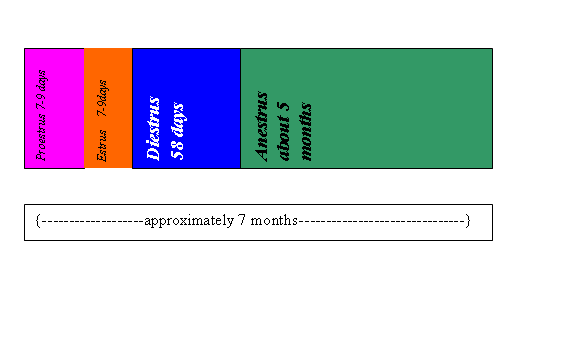
Proestrus is a phase, about 7-9 days in length, where as estrogen levels climb, her vulva begins to swell and enlarge, a bloody vaginal discharge can be noted and she becomes increasingly attractive to intact male dogs although will usually not stand to be mated. Changes on vaginal smears can be used to identify this part of the bitch's cycle by your veterinarian. Towards the end of this phase, estrogen (E2) falls and progesterone (P4) begins to climb. The pituitary releases luteinizing hormone (LH) in a single burst at the juncture between proestrus and estrus.
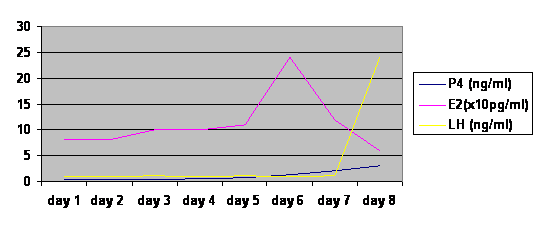
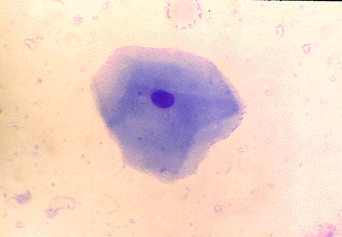
Image of a cornified vaginal epithelial cell
Non-cornified cells are typical of anestrus, early to mid proestrus and diestrus; cornification occurs under the stimulation of estrogen from late proestrus to estrus. Note changes in cytology lag behind actual hormonal fluctuations.
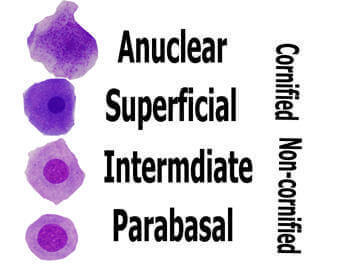
Estrus is also about 7-9 days in length and typically some of the vulvar swelling subsides as estrogen levels fall and the vaginal discharge may change from bloody to straw colored. The bitch will usually stand rigidly, holding her tail to one side (known as flagging) and allow the male to mount. This is the fertile period of the bitch's cycle usually beginning with progesterone climbing above 2 ng/ml, signals sent to her pituitary to induce ovulation, followed by ovulation, maturation of the released eggs and fertilization and then closure of the cervix and refusal to stand for the male and be mated. Various changes in the levels of rising progesterone can be used by your veterinarian to time the events of estrus and predict ovulation and the optimal time for breeding. Timing these events no only permits efficient use of semen, but can optimize litter sizes and permit use of even subfertile semen samples of stud's of superior genetic merit. Knowing the date of ovulation can also permit more accurate prediction of a future whelping date or permit choice of an elective Cesarian section for delivery of live, healthy puppies.
In the following graph, ovulation would be taking place at day 3 (about 48 hours post the LH peak) and oocytes would be most fertile between days 5-7
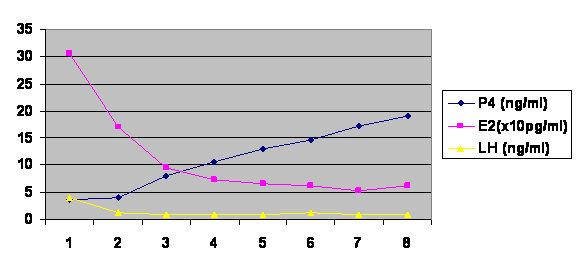
Diestrus follows estrus and is typically 58 days in length. A sudden change in vaginal cytology from estrus to diestrus can often be identified and usually there is a sharp disinterest in mating from the bitch as well. Vaginal cytology to identify the first day of diestrus can assist in predicting future whelping dates, but is not helpful in predicting ovulation/optimal breeding dates as it is retrospective information. It can however be additional supportive evidence of breeding at a correct estimated date for optimal fertility even if it won't change the outcome. A bitch will undergo diestrus whether she is pregnant or not. Actually, the length of diestrus is a little shorter for pregnant bitches (about 58 days) than non-pregnant bitches (up to 70 days). Either way, it's about 2 months for the corpora lutea (structures formed in the ovaries that secrete progesterone, formed after ovulation of the eggs) disappear and progesterone (P4) levels fall to baseline again. Estrogen rises towards the end of diestrus which helps to soften the cervix and lubricate the vaginal canal in preparation for whelping- mild to marked vaginal edema may be noted at this time. LH may show a few peaks at the onset of lactation and if the bitch is nursing, after an initial rise and fall in prolactin (PrL), the prolactin will again continue to rise into lactation. If not nursing, prolactin would just fall to basal levels and not climb a second time.
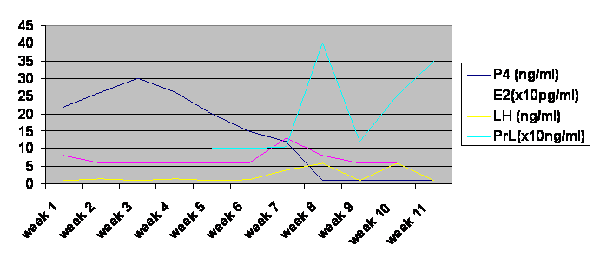
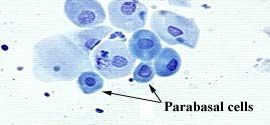
Image of diestrus cytology
Anestrus is a period of relative endocrine quiescence that lasts about 4-5 months. The vaginal epithelium is very thin, there are very few cells seen on vaginal cytology and the bitch is otherwise unreceptive to mating. Despite that, follicular activity and growth does occur to some extent and small increase in estradiol can be seen. Towards the end of anestrus, release of hormones from the dog's hypothalamus and pituitary gear her up for re-entry into proestrus; LH is release in short frequent bursts. It is both this phase and diestrus that can be manipulated by medications to shorten the bitch's cycle.
The following chart shows hormonal fluctuations early and late in anestrus(weeks 1-20)
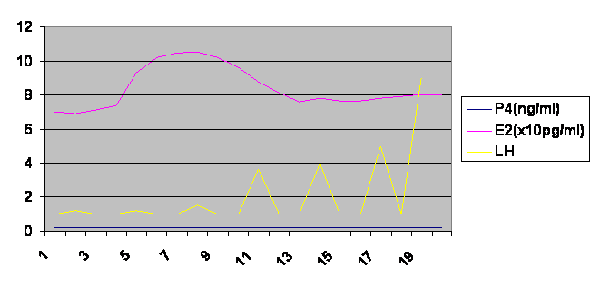
Why manipulate the reproductive cycle of the bitch?
1: Mismating may have occurred or there may be illness/trauma that would prevent a normal healthy delivery so termination of a pregnancy is desirable. After confirmation of pregnancy at about 25 days, hormones to terminate the lifespan of the corpora lutea can be used to shorten diestrus. The breeder may have missed the opportunity for breeding in which case, shortening the cycle may permit more planning and readiness for the next opportunity for breeding. Finally pyometra may have occurred where it is medically or surgically necessary to intervene.
2: Puppies are desired at times of the year outside of the bitch's normal breeding cycle.
3: The availability of the stud/semen will not permit use during the bitch's normal breeding cycle.
4: Use of the bitch for shows/competition/work will not permit breeding. Search and rescue dogs would be a fine example of this problem.
If you have questions about breeding your bitch or use of advanced reproductive technologies, please contact our theriogenologist on staff, Dr Mary Sebzda, DVM, DACT. She will be only too happy to answer your questions and assist you in your future plans and goals.
References:
Canine and Feline Theriogenology. S Johnston, M Root Kustritz, P Olson. WB Saunders Co. Philadelphia, PA 2001
LSU Comparative Theriogenology webpage. Canine Theriogenology. www.vetmed.lsu.edu/eiltslotus/Theriogenology-5361/canine_index.htm
Our Pet Health Mission
Our mission at Newport Harbor Animal Hospital is: "To provide the highest quality veterinary care for our patients and the best service for our clients. Our goal in every case is a healthy pet and a happy client."
